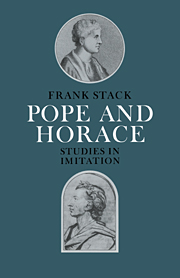Book contents
- Frontmatter
- Contents
- Acknowledgements
- List of abbreviations
- Preface
- PART I INTRODUCTIONS
- PART II THREE HORATIAN SATIRES (1733–4)
- PART III MATURE HORACE (1736–7)
- PART IV THE TIME OF TENSION (1738)
- 9 Idealism and scepticism: The Imitation of Epistle I.vi.
- 10 Fables of the self: The Imitations of Satire II.vi. and Epistle I.vii.
- 11 The Stoic self: The Imitation of Epistle I.i.
- Epilogue
- Appendix: Imitations of Horace published 1730–40
- Notes
- Bibliography
- Index
10 - Fables of the self: The Imitations of Satire II.vi. and Epistle I.vii.
Published online by Cambridge University Press: 08 January 2010
- Frontmatter
- Contents
- Acknowledgements
- List of abbreviations
- Preface
- PART I INTRODUCTIONS
- PART II THREE HORATIAN SATIRES (1733–4)
- PART III MATURE HORACE (1736–7)
- PART IV THE TIME OF TENSION (1738)
- 9 Idealism and scepticism: The Imitation of Epistle I.vi.
- 10 Fables of the self: The Imitations of Satire II.vi. and Epistle I.vii.
- 11 The Stoic self: The Imitation of Epistle I.i.
- Epilogue
- Appendix: Imitations of Horace published 1730–40
- Notes
- Bibliography
- Index
Summary
Horace, pour faire sa cour à Mecenas, témoigne dans cette Satire [II.vi.], qu'il est content de sa fortune, & que les graces qu'il a receuës de luy, l'ont mis en estat de ne pouvoir rien souhaiter.
(Dacier, VII, p.452)Hoc erat in votis, modus agri, &c., and concha salis puri. Off, off with these masks.
(Shaftesbury, 1900, p. 109)On 1 march 1738, just one week before he brought out his last Imitation of Horace, the Imitation of Epistle I.i., Pope published a reprint of Swift's Imitation of Horace's Satire II.vi. with a conclusion done by himself. Swift's Imitation of the main section of Horace's satire had been written in August 1714, and been printed for the first time in the ‘last’ volume of the Pope/Swift Miscellanies of 1727, without the Latin text. Now Pope printed it alongside the whole of the Latin poem with index numbers which he, presumably, introduced himself. His version of the end of the satire, the story of the town mouse and the country mouse, is done in octosyllabic couplets. As such it is not only an ‘Imitation of Horace’, but also an Imitation of Swift.
In 1739 he included in his collected works an addition to another of Swift's Imitations. Swift had published in 1713 an Imitation of the famous story of Philippus and Volteius which ends Horace's Epistle I.vii., adapted to portray ironically the relationship between himself and Harley. Pope's poem is an Imitation, again in the Swiftian mode, of the first part of this Horatian epistle, and, though in fact ‘complete’ in itself, it ends by suggesting one should read the rest of the poem in Swift's version.
- Type
- Chapter
- Information
- Pope and HoraceStudies in Imitation, pp. 222 - 244Publisher: Cambridge University PressPrint publication year: 1985

